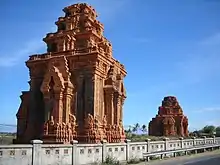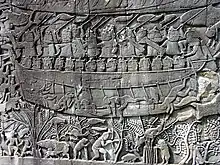Khmer–Cham wars
Khmer–Cham wars were a series of conflicts and contests between states of the Khmer Empire and the kingdom of Champa, later involved Đại Việt, lasted from mid-10th century to early 13th century on mainland Southeast Asia. The first conflict began in 950 AD when Khmer troops sacked the Cham principality of Kauthara. Tensions between the Khmer Empire and the Champa kingdom reached climax in the middle of the 12th century when both deployed field armies and waged devastate wars on each other. The conflicts ended after the Khmer army voluntary retreated from occupying Champa back to their state in 1220.
Part of a series on the |
|---|
| History of Cambodia |
| Early history |
| Post-Angkor Period |
| Colonial period |
| Contemporary era |
| Timeline |
|
|
Part of a series on the |
|---|
| History of Champa |
 |
Khmer invasion of Kauthara (950)

Around 950, the Khmer under Rajendravarman II pillaged the temple of Po Nagar (Kauthara) and carried off the statue of the goddess.[1] In 965, the Cham King Jaya Indravaman I restored the temple at Po Nagar and reconstructed the statue of the goddess to replace the one stolen by the Khmer.[2][1]
Khmer invasions of Northern Champa (1074–1080)
In 1074, Harivarman IV became king of Champa, had close ties to Sung China, made peace with Dai Viet but provoked war with the Khmer Empire.[3][4][5] In 1080, a Khmer army attacked Vijaya and other centers in northern Champa. Temples and monasteries were sacked and cultural treasures were carried off. After much misery, Cham troops under King Harivarman were able to defeat the invaders and restored the capital and temples.[6] His raiding force penetrated Cambodia as far as Sambor and the Mekong, where it destroyed all religious sanctuaries.[7] Also in previous years Đại Việt reorganized her royal army, equipped them with cavalries and catapults.[8]
Suryavarman II's wars (1128–1150)

In 1127, Suryavarman II demanded Vietnamese king Lý Dương Hoán to pay tribute for the Khmer Empire, but the Vietnamese refused. Suryavarman decided to expand his territory northward into Vietnamese territory.[9] The first attack was in 1128 when King Suryavarman II led 20,000 soldiers from Savannakhet to Nghệ An but were routed in battle.[10] The following year Suryavarman continued skirmishes on land and sent 700 ships to bombard the coastal areas of Đại Việt. In 1132, he persuaded Cham king Jaya Indravarman III to join with him attack Đại Việt, briefly seizing Nghệ An, pillaged the coastal districts of Thanh Hoá.[7][10]
In 1136, the Vietnamese force under Đỗ Anh Vũ counterattacked the Khmers with 30,000 men, but later retreated.[9] The Cham thereupon made with the Vietnamese, and when Suryavarman renewed the attack, Jaya Indravarman refused to cooperate with the Khmers.[7] After failed attempt to seize seaports in southern Đại Việt, Suryavarman II turned to invade Champa in 1145, and sacked Vijaya, ending the reign of Jaya Indravarman III, and destroying the temples at Mỹ Sơn.[11][12][13] They occupied northern Champa until 1149, when they were drove out by Jaya Harivarman I from Panduranga.[11] Harivarman reunited the kingdom. A royal pretender, Vamsaraja, attacked Harivarman with highland troops but was failed and escaped to Đại Việt.[14]
Cham invasions of Angkor (1170–1177)
After securing peace with Đại Việt in 1170, Cham forces under Jaya Indravarman IV invaded the Khmer Empire through land with inconclusive results.[14] In 1177, however, his troops launched a surprise attack against the Khmer capital of Yasodharapura from warships piloted up the Mekong River to the great lake Tonlé Sap in Cambodia, and killed the Khmer king Tribhuvanadityavarman.[15][16][17] Multiple-bow siege crossbows were introduced to Champa from Song dynasty in 1171, and later were mounted on the backs of Cham and Vietnamese war elephants.[18][19] They were deployed by the Cham during the siege of Angkor, which was defended only by wooden palisades, led to the Cham occupation of Cambodia for next four years.[18]
Jayavarman VII's conquest of Champa (1190–1203)
In 1190, the Khmer king Jayavarman VII appointed a Cham prince named Vidyanandana who had been educated at Angkor to lead the Khmer army. Vidyanandana defeated the invaders and proceeded to occupy Vijaya and to capture Jaya Indravarman IV, whom he sent back to Angkor as a prisoner.[20][21] Adopting the title of Shri Suryavarmadeva (or Suryavarman), Vidyanandana made himself king of Panduranga, which became a Khmer's vassal. He made Prince In, a brother-in-law of Jayavarman VII, "King Suryajayavarmadeva in the Nagara of Vijaya" (or Suryajayavarman). In 1191 a revolt at Viajaya drove Suryajayavarman back to Cambodia and enthroned Jaya Indravarman V. Vidyanandana occupied Vijaya, killed both Jaya Indravarman IV and Jaya Indravarman V, then "reigned without opposition over the Kingdom of Champa,"[21][22] but he declared his independence from the Khmer Empire.
Khmer armies under Jayavarman VII continued campaigning against Champa until the Chams were finally defeated in 1203.[23] The Khmer later also had double bow crossbows mounted on elephants, which Michel Jacq Hergoualc’h suggest were elements of Cham mercenaries in Jayavarman VII's army.[19] The Khmer sent the Cham king Suryavarman into exile.[24] Jayavarman VII added Champa into his empire as a province, until the Chams regained independence in 1220.[25][13] Followed the Khmer voluntary evacuation of Champa, a Cham prince of the old royal line took over the reins of government peacefully and proclaimed himself Jaya Paramesvaravarman II and restored Champa's sovereigns.[26][22]
References
Citation
- Coedès 1968, p. 124.
- Maspero 2002, p. 56.
- Maspero 2002, p. 72.
- Coedès 1968, p. 152–154.
- Hubert 2012, p. 222.
- Ngô 2005, p. 188.
- Hall 1981, p. 205.
- Chapius 1995, p. 76.
- Kiernan 2017, pp. 162–163.
- Kohn 2013, pp. 524.
- Coedès 1968, p. 160.
- Maspero 2002, p. 75–76.
- Miksic & Yian 2016, p. 436.
- Hall 1981, p. 206.
- Maspero 2002, p. 78.
- Coedès 1968, p. 164-166.
- Higham 2004, p. 120.
- Turnbull 2001, p. 44.
- Liang 2006, p. 57.
- Coedès 1968, p. 170.
- Maspero 2002, p. 79.
- Hall 1981, p. 207.
- Ngô 2005, p. 189.
- Maspero 2002, p. 80.
- Coedès 1968, p. 171.
- Maspero 2002, p. 81.
Bibliography
- Maspero, Georges (2002). The Champa Kingdom. White Lotus Co., Ltd. ISBN 9789747534993.
- Chapuis, Oscar (1995). A history of Vietnam: from Hong Bang to Tu Duc. Greenwood Publishing Group. ISBN 0-313-29622-7.
- Kohn, George Childs (2013). Dictionary of Wars. Routledge. ISBN 978-1-13-595494-9.
- Coedès, George (1968). Vella, Walter F. (ed.). The Indianized States of Southeast Asia. trans.Susan Brown Cowing. University of Hawaii Press. ISBN 978-0-8248-0368-1.
- Hall, Daniel George Edward (1981). History of South East Asia. Macmillan Education, Limited. ISBN 978-1349165216.
- Tully, John (2006), A Short History of Cambodia: From Empire to Survival, Allen & Unwin
- DiBiasio, Jame (2013), The Story of Angkor, Silkworm Books
- Hubert, Jean-François (2012), The Art of Champa, Parkstone International
- Tarling, Nicholas (1999). The Cambridge History of Southeast Asia: Volume 1, From Early Times to c.1800. Cambridge University Press. ISBN 978-0-521-66372-4.
- Turnbull, Stephen (2001), Siege Weapons of the Far East (1) AD 612-1300, Osprey Publishing
- Audric, John (1972), Angkor and the Khmer Empire, R. Hale
- Liang, Jieming (2006). Chinese Siege Warfare: Mechanical Artillery & Siege Weapons of Antiquity. Singapore, Republic of Singapore: Leong Kit Meng. ISBN 981-05-5380-3.
- Aymonier, Etienne (1893). The History of Tchampa (the Cyamba of Marco Polo, Now Annam Or Cochin-China). Oriental University Institute. ISBN 978-1149974148.
- Higham, Charles (2004). The Civilization of Angkor. University of California Press. ISBN 978-0-520-24218-0.
- Miksic, John Norman; Yian, Go Geok (2016). Ancient Southeast Asia. Taylor & Francis. ISBN 1-317-27903-4.
- Kiernan, Ben (2019). Việt Nam: a history from earliest time to the present. Oxford University Press.
- Ngô, Văn Doanh (2005). Mỹ Sơn relics. Hanoi: Thế Giới Publishers. OCLC 646634414.
